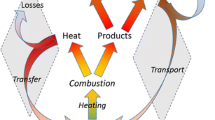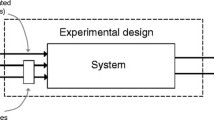Abstract
The NRCC model of fully developed compartment fires is discussed. Although the mathematics involved is quite simple, it allows a rather comprehensive simulation of the fire process. The model offers an explanation for the findings that ‘ventilation control’ is related to the pyrolysis mechanism and is not a result of scarcity of air in the fire compartment, and that thermal feedback is of secondary importance in the “burning” (pyrolysis) of cellulosic fuels. Another feature of the model is the introduction of the normalized heat load concept. The normalized heat load is a scalar quantity that depends on the total heat absorbed by the compartment boundaries during the fire incident, and is practically independent of the temperature history of the fire. A simple explicit formula has been proposed and proved experimentally to describe the normalized heat load for real-world fires with fair accuracy. The normalized heat load concept offers a simple means for converting fire severities into fire resistance requirements, and makes it possible to design buildings for prescribed levels of structural fire safety. The potential of fires to spread by convection and the expected characteristics of fires of noncharring plastics are also discussed.
Similar content being viewed by others
References
Harmathy, T. Z., and Mehaffey, J. R., “Post-flashover Compartment Fires,”Fire and Materials, Vol. 7, 1983, p. 49.
Harmathy, T. Z., “A New Look at Compartment Fires,” Parts I and II,Fire Technology, Vol. 6, 1972, pp. 196, 326.
Harmathy, T. Z., “Burning, Pyrolysis, Combustion and Char-oxidation: Need for Clarifying Terminology,”Fire and Materials, Vol. 8, 1984, p. 224.
Harmathy, T. Z., “Mechanism of Burning of Fully-developed Compartment Fires,”Combustion and Flame, Vol. 31, 1978, p. 265.
Harmathy, T. Z., “Effect of the Nature of Fuel on the Characteristics of Fully-developed Compartment Fires,”Fire and Materials, Vol. 3, 1979, p. 49.
Harmathy, T. Z., “Experimental Study of the Effect of Ventilation on the Burning of Piles of Solid Fuels,”Combustion and Flame, Vol. 31, 1978, p. 259.
Harmathy, T. Z., “Some Overlooked Aspects of the Severity of Compartment Fires,”Fire Safety Journal, Vol. 3, 1981, p. 261.
Harmathy, T. Z., “The Role of Thermal Feedback in Compartment Fires,”Fire Technology, Vol. 11, 1975, p. 48.
Nilsson, L., “The Effect of the Porosity and Air Flow Factor on the Rate of Burning for Fire in Enclosed Space,” National Swedish Building Research Summaries, R22, 1971.
Pettersson, O., Magnusson, S. E., and Thor, J., “Fire Engineering Design of Steel Structures,” Swedish Institute of Steel Construction, Stockholm, Bulletin 50, 1976.
Harmathy, T. Z., “Fire Severity: Basis of Fire Safety Design,” inFire Safety of Concrete Structures, ACI Publication SP-80, American Concrete Institute, Detroit, 1983, p. 115.
Mehaffey, J. R. and Harmathy, T. Z., “Assessment of Fire Resistance Requirements,”Fire Technology, Vol. 17, 1981, p. 221.
Harmathy, T. Z., “The Possibility of Characterizing the Severity of Fires by a Single Parameter,”Fire and Materials, Vol. 4, 1980, p. 71.
Harmathy, T. Z., and Mehaffey, J. R., “Normalized Heat Load: A Key Parameter in Fire Safety Design,”Fire and Materials Vol. 6, 1982, p. 27.
Harmathy, T. Z., “The Fire Resistance Test and Its Relation to Real-world Fires,”Fire and Materials, Vol. 5, 1981, p. 112.
Mehaffey, J. R., and Harmathy, T. Z., “Thermal Response of Compartment Boundaries of Fire,” presented at the First International Symposium on Fire Safety Science, National Bureau of Standards, Gaithersburg, MD, October 1985.
Butcher, E. G., Chitty, T. B., and Ashton, L. A., “The Temperatures Attained by Steel in Building Fires,” Fire Research Technical Paper No. 15, Joint Fire Research Organization, England 1966.
Butcher, E. G., Bedford, G. K., and Fardell, P. J., “Further Experiments on Temperatures Reached by Steel in Buildings,” Paper 1, Proceedings of Symposium held at Fire Research Station, January 1967, Joint Fire Research Organization, England, 1968, p. 1.
ASTM E5.11 task group on “Repeatability and Reproducibility of Results of ASTM E-119 Fire Tests,” Research Report No. RR: E5-1003 available from ASTM, Philadelphia, PA, 1982.
Harmathy, T. Z., and Mehaffey, J. R., “Design of Buildings for Prescribed Levels of Structural Fire Safety,” inFire Safety: Science and Engineering, ed. T. Z. Harmathy, ASTM STP 882, Philadelphia, PA 1985.
Zahn, J. J., “Reliability-based Design Procedures for Wood Structures,”Forest Products Journal Vol. 27, 1977, p. 21.
Woeste, F. E., and Schaffer, E. L., “Second Moment Reliability Analysis of Fire Exposed Wood Joist Floor Assemblies,”Fire and Materials, Vol. 3, 1979, p. 126.
Harmathy, T. Z., “Design to Cope with Fully Developed Fires,” inDesign of Buildings for Fire Safety, eds, E. E. Smith and T. Z. Harmathy, ASTM STP 685, Philadelphia, PA, 1979, p. 198.
Author information
Authors and Affiliations
Additional information
Reference: T. Z. Harmathy, “Postflashover Fires—An Overview of the Research at the National Research Council of Canada (NRCC), 1970–1985,”Fire Technology, Vol. 22, No. 3, August 1986, p. 210.
Rights and permissions
About this article
Cite this article
Harmathy, T.Z. Postflashover fires — an overview of the research at the national research council of Canada (NRCC), 1970–1985. Fire Technol 22, 210–233 (1986). https://doi.org/10.1007/BF01043125
Received:
Accepted:
Issue Date:
DOI: https://doi.org/10.1007/BF01043125




